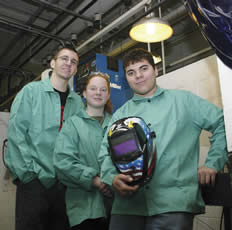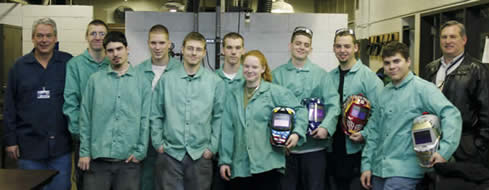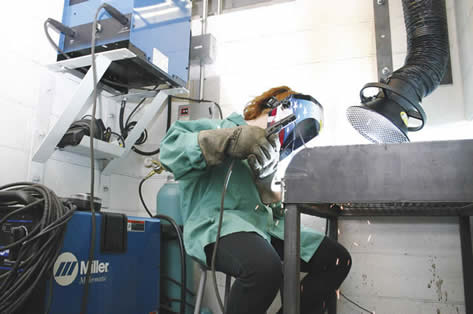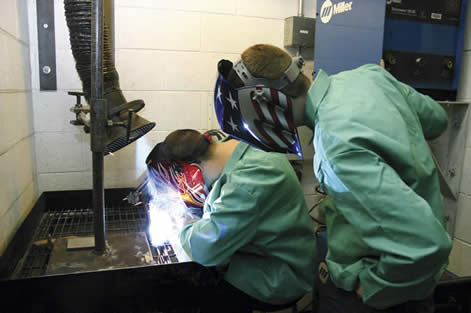 |
| A bright future—Delcastle Technical High School is working to reverse the shortage of qualified welders. |
If you build it they will come or so goes the quote from the 1989 movie Field of Dreams. But we aren't talking about a game of baseball, and the field is not a baseball diamond. This field of dreams is a technical high school, located in New Castle, Delaware, a suburb of Wilmington. Shoeless Joe Jackson is nowhere to be seen, but Welding and Fabrication instructor Doc Stanaitis can always be found walking up and down the aisles, teaching his students the ins and outs of the different welding processes.
If You Build It, They Will Come
It is no secret that the United States has a lack of skilled trade workers. In fact, in 2004 the nation saw one of the largest shortages of qualified welders ever. Such an emphasis has been placed on going to college that skilled trades are often ignored among graduating high school seniors as a viable career path. In addition, many welders are facing retirement with few upcoming apprentices moving up in the ranks to take their place. The age of computers has also played a part in the decrease of skilled welders. Instead of choosing welding as a career, many potential welders, who like to work with their hands, have gone into the computer industry. But there is not one distinct reason that has caused a lack of skilled welders, nor are any of the possible reasons of the utmost importance. The solution to the problem needs to be the main focus. Welding equipment manufacturers, their distributors and technical schools such as Delcastle Technical High School are playing a key role in acknowledging the shortage and reversing this downward spiral.
"Revitalizing the skilled trades is not a one person or one industry job," states Mike Weller, president, Miller Electric Mfg. Co., a welding equipment manufacturer. "It is a partnership between manufacturers, distributors and technical schools."
Like many schools in the United States, Delcastle Technical High School was feeling the pain of falling enrollment in the Welding and Fabrication program. Its program was down to only 19 students-unable to produce enough graduates for businesses in the area who relied on Delcastle graduates and unable to offer the students a quality program given the lack of funding they faced. It was a cyclical problem with no clear-cut solution. Without an increase in students there could not be an increase in funding, and therefore no improvements to the program could be made. Conversely, without program improvements, students were unlikely to enroll, adding to the problem.
A "Doc"tor To The Rescue
In September 2001, Doc Stanaitis came into the picture at Delcastle. With a background in fabrication and metalworking, Doc knew exactly what the school needed to improve the program. Beginning with only 19 students in September 2001, Doc increased enrollment in his program to 55-day students and 60-night students by May 2005. Doc attributes this amazing turnaround to the students and his welding supply distributor, basically giving credit to everyone but himself.
 |
| Doc Stanaitis (left), and Willard Keen (right), worked as a team to revitalize the Welding and Fabrication Program at Delcastle Technical High School. |
Willard Keen of Keen Compressed Gas, Doc's welding supply distributor, states, "Doc is the main reason behind the success of this program. He is a modest man, and yes it was a team effort, but without Doc this program would not be what it is today. Doc's charisma and camaraderie with his students is the key to its success."
Doc feels it is important that students are allowed to make decisions. To be sure his students are not bystanders to their own education, Doc empowers his students to make positive decisions in their lives both inside and outside of the classroom.
When Doc arrived, the career area was one that needed updating. Doc set out to make the work area more comfortable, more technologically advanced and more appealing to his students. Upon his hiring, Doc immediately established his student's "ownership" of the workspace and the changes made to it. Basically, Doc made the reorganization of the career area into a learning experience.
 |
| In less than one month, students designed, selected materials and welded the workstations that they use each day advancing their skills while taking ownership in the program. |
"The students actually made all of the tables they currently fabricate on," states Doc. "They were able to choose where they wanted to sit, how wide the tables should be and what types of stands they wanted to make. They designed it, drew it up, bought the materials and installed it all by themselves in less than one month."
By giving students ownership of their program, Doc fostered a trusting relationship with his students, enabling them to develop and nurture new students coming into the program.
"The success of this program can be attributed in part to the mentoring that goes on between new students and upperclassman," states Doc. "We really try to train our students to take time out to help their fellow students along in the program."
The Curriculum
After the students' workspace was in useable order, Doc's next line of business was modifying a curriculum that would help students achieve the skills that area businesses required of their new recruits. The curriculum at Delcastle is based on NCCER certifications, which is the National Center for Construction Educational Research. The interesting part of the curriculum is that it is task-based. Therefore, even students with limited welding skills are able to graduate from high school with certain certifications. Those students with exceptional welding capabilities, who work hard and stay focused, can graduate high school as a certified American Welding Society entry level welder, and have the opportunity to enroll as a registered state apprentice, which benefits not only the students, but also the companies that are hiring Delcastle graduates.
The NCCER curriculum prepares students for the real world, yet not all Delcastle graduates go directly into the work force. The curriculum at Delcastle enables students to graduate with enough credits academically that they can take their education further and apply to universities in the area, such as the University of Delaware, Delaware State and Delaware Technical and Community College. Those students who accept jobs upon graduation, however, find that Delcastle prepared them for their careers throughout the three-year program.
Incoming freshman come in for six weeks in the forth marking period to learn about their chosen trade and then go back to their Freshman Transition Academies. The students then return to welding for their entire sophomore, junior and senior years. All students that are eligible can co-op at an area company during the summer after they complete their junior year. Depending on the situation, students are sometimes able to co-op during the school year in two-week increments. Students will go to work for two weeks and receive work-related training, then return to Delcastle for two weeks to work toward their NCCER certifications and general academics.
 |
| Mentoring between new students and upperclassmen contribute to much of the programs success. |
Students are encouraged to excel in the welding processes they enjoy and do exceptionally well. "In a perfect world, we would have all of our students come in each year and be able to do each welding process perfectly, but this is not a perfect world," states Doc. "If a student is struggling with Stick but starts excelling at MIG (Gas metal arc welding), we'll concentrate his or her efforts on MIG and try to get him as many certifications in that process as possible."
Doc believes his job is to train his students the best he can in the time he has with them. And he does.
Outdated Equipment
By working with an advisory board, Doc has been able to keep in touch with today's business needs and initially found that the school's equipment was not helping to produce the skills students needed upon entering the workforce. When Doc started instructing at the school, a majority of the workstations were equipped only with oxyfuel torches for welding, brazing and soldering. While oxyfuel training is still an important proponent of the students' education, the businesses in the area were moving away from oxyfuel and focusing more on MIG, TIG and Stick welding for their daily needs.
Through a partnership with Tom Bruno, and Willard Keen of Keen Compressed Gas, and the Newcastle County Vocational School District. Doc was able to secure brand new Miller Electric welding equipment for the school-machines that would help students to become more proficient in the skills needed by the businesses in the area. Tom Bruno assessed the situation at Delcastle and recommended new Miller Syncrowave® 180 TIG/Stick welding power sources and Millermatic® 210 MIG arc welding power sources.
"The school had very minimal MIG and TIG capabilities before Doc started," states Bruno. "And we all thought it was important that the students learn the processes needed in the real world on the machines they would be using in the real world."
A majority of the student's work booths are now multi-process, providing students the ability to MIG, TIG and Stick weld without leaving their designated areas. Most of the oxy-fuel stations are gone, although some remain to teach new students how to see the weld puddle, which is sometimes tricky with MIG, TIG and Stick welding.
"I love coming to Delcastle and seeing the brand new blue Miller welding equipment," states Keen. "I think it boosts student's morale by having new equipment to work with. It shows the students that the school district cares about them and their future."
Students also like the new equipment because of its simplicity and ease of use. Before, students were content to stay on one machine throughout their tenure at the school. Now students are scrambling to get a chance on one of the new Miller machines.
Given all of the recent improvements and renovations, students are also scrambling just to get into the Welding and Fabrication program at Delcastle. From September to December of 2004, Delcastle had over 200 students tour the shop. There will be approximately 30 students applying for 15 freshman positions, quite an accomplishment considering that in September 2001 the school was down to 19 students total. With a charismatic leader, new curriculum and new welding equipment from Miller Electric, Delcastle's success is truly an inspiration for other vocational programs in the country.